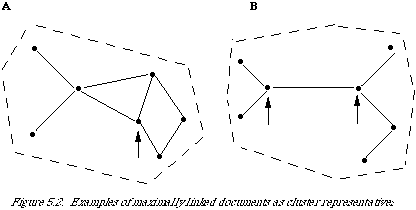|
|
99 |
|
|
|
|
The main difficulty with this kind of search strategy is the specification of the threshold or cut-off. It will always be arbitrary since there is no way of telling in advance what value for each query will produce the best retrieval.
Cluster representatives
Before we can sensibly talk about search strategies applied to clustered document collections, we need to say a little about the methods used to represent clusters. Whereas in a serial search we need to be able to match queries with each document in the file, in a search of a clustered file we need to be able to match queries with clusters. For this purpose clusters are represented by some kind of profile (a much overworked word), which here will be called a cluster representative. It attempts to summarise and characterise the cluster of documents.
A cluster representative should be such that an incoming query will be diagnosed into the cluster containing the documents relevant to the query. In other words we expect the cluster representative to discriminate the relevant from the non-relevant documents when matched against any query. This is a tall order, and unfortunately there is no theory enabling one to select the right kind of cluster representative. One can only proceed experimentally. There are a number of 'reasonable' ways of characterising clusters; it then remains a matter for experimental test to decide which of these is the most effective.
Let me first give an example of a very primitive cluster representative.
If we assume that the clusters are derived from a cluster method based on a dissimilarity measure, then we can represent each cluster at some level of dissimilarity by a graph (see Figure 5.2).
Here
|
|
|
99 |
|
|
|
